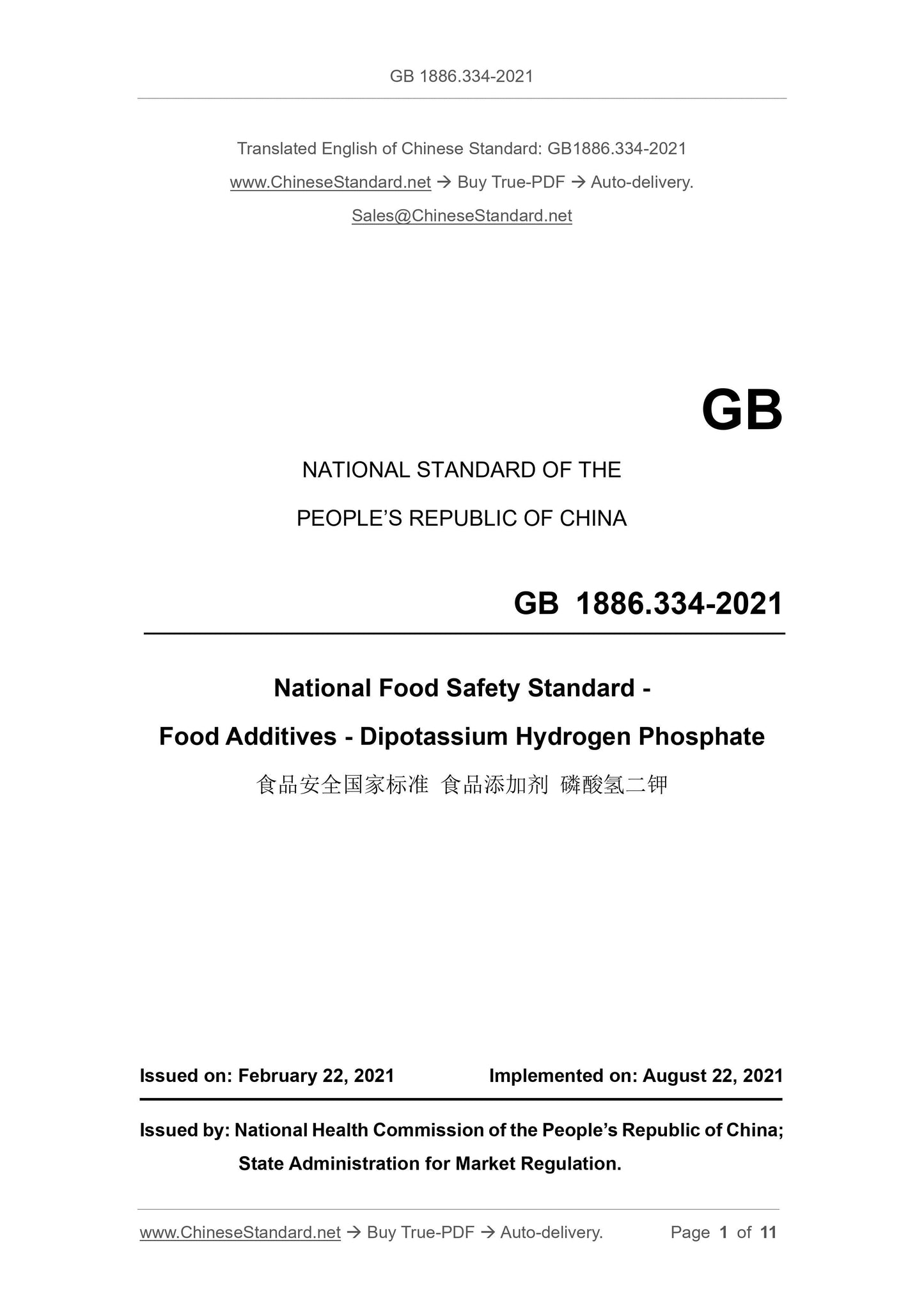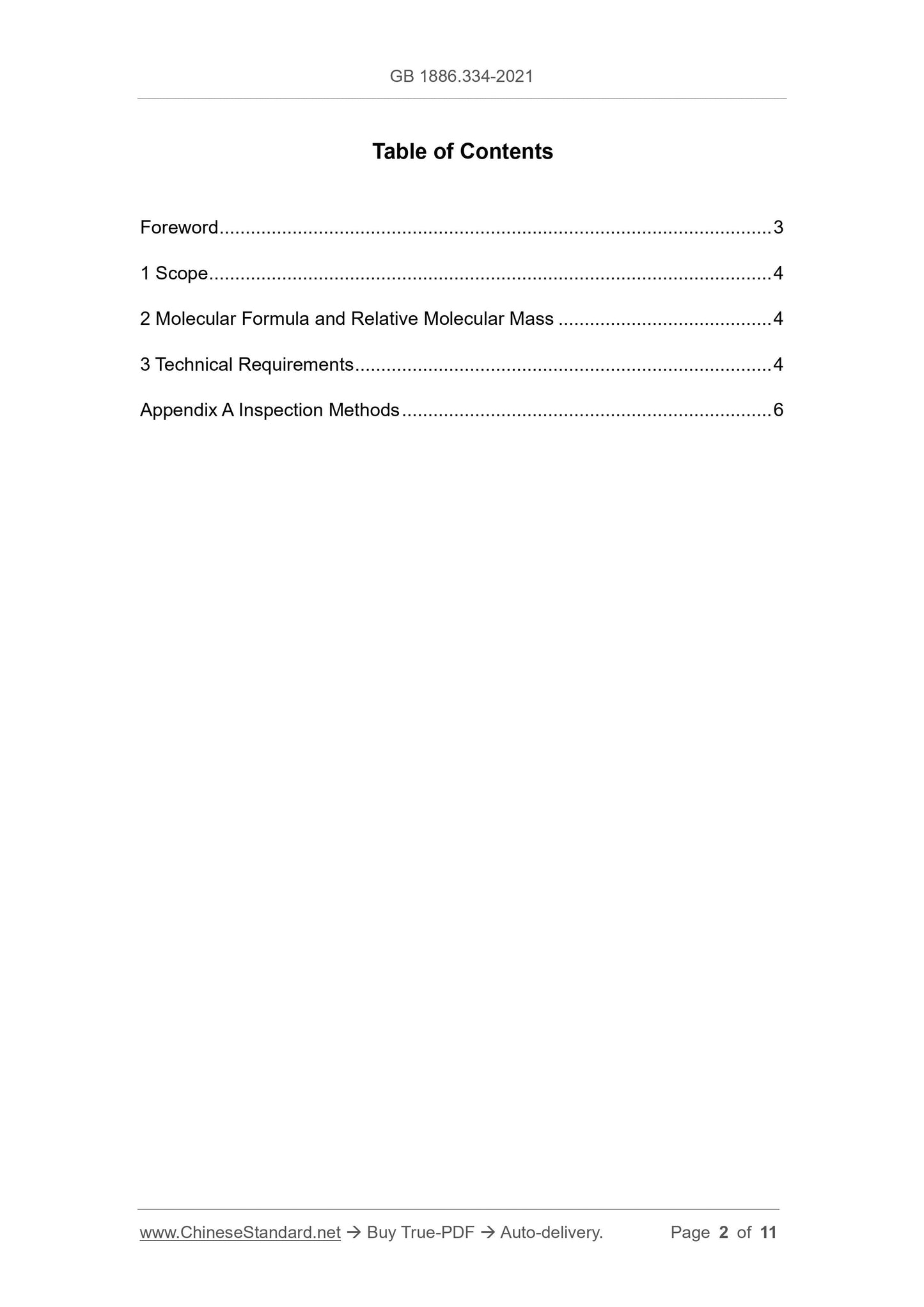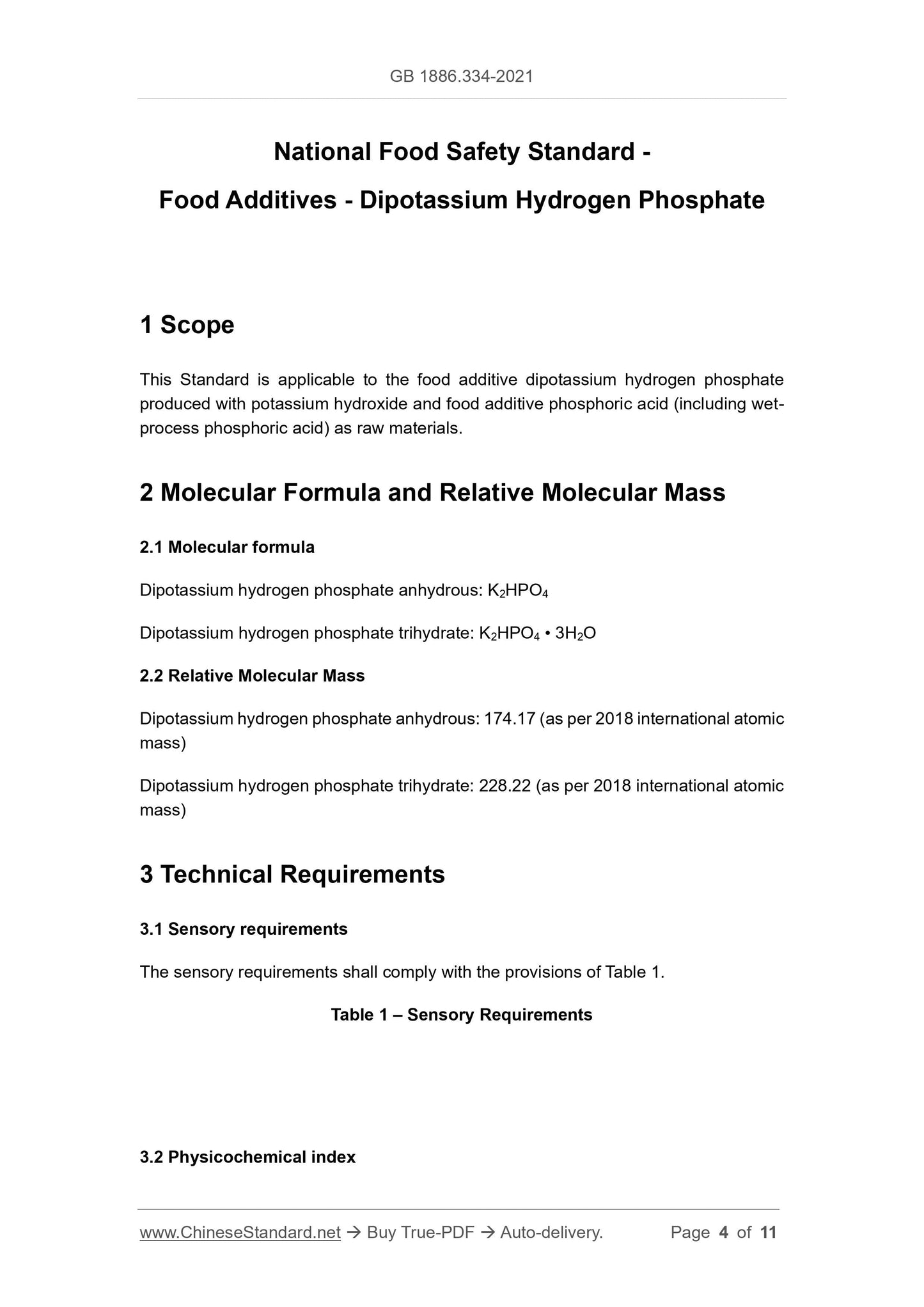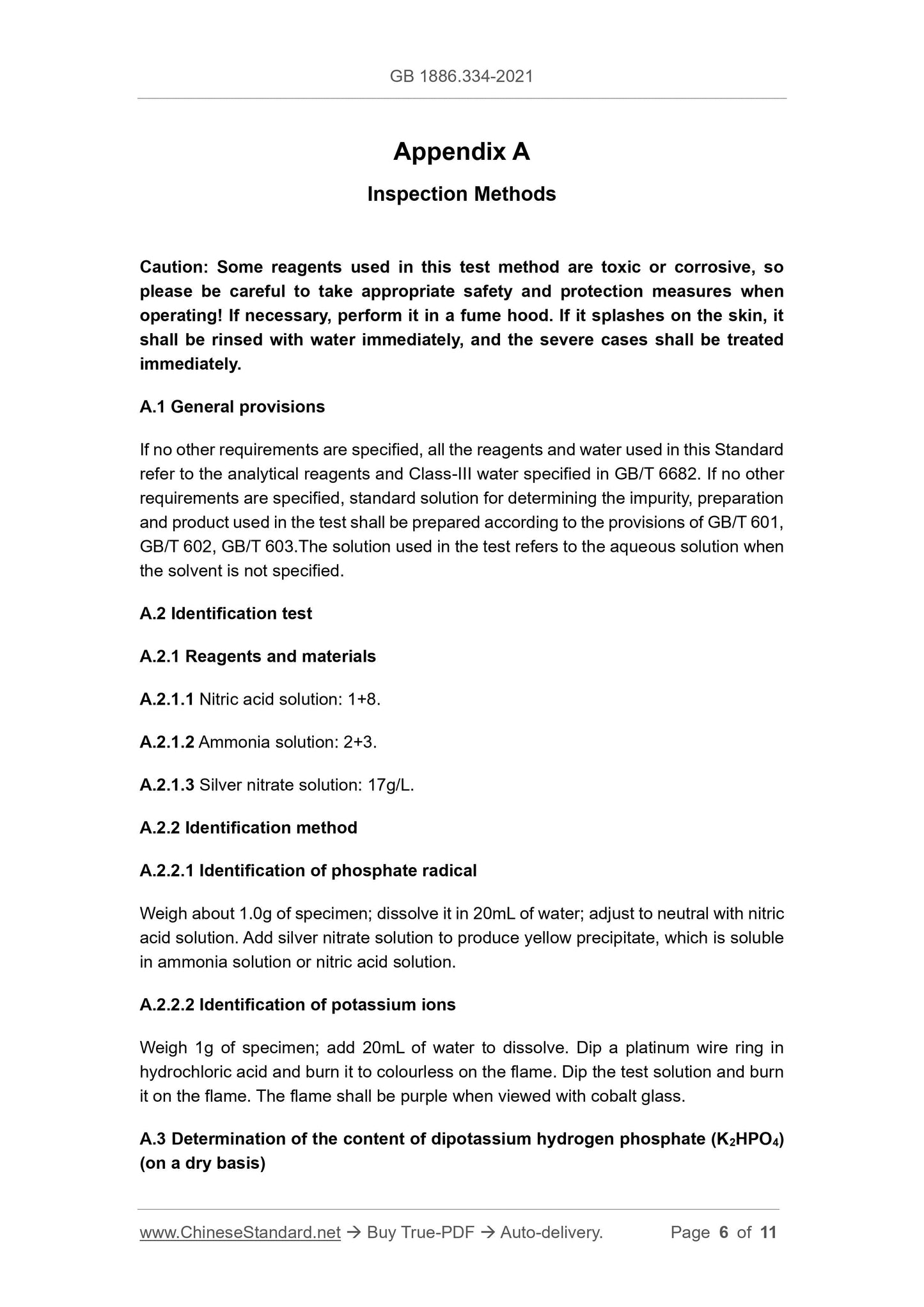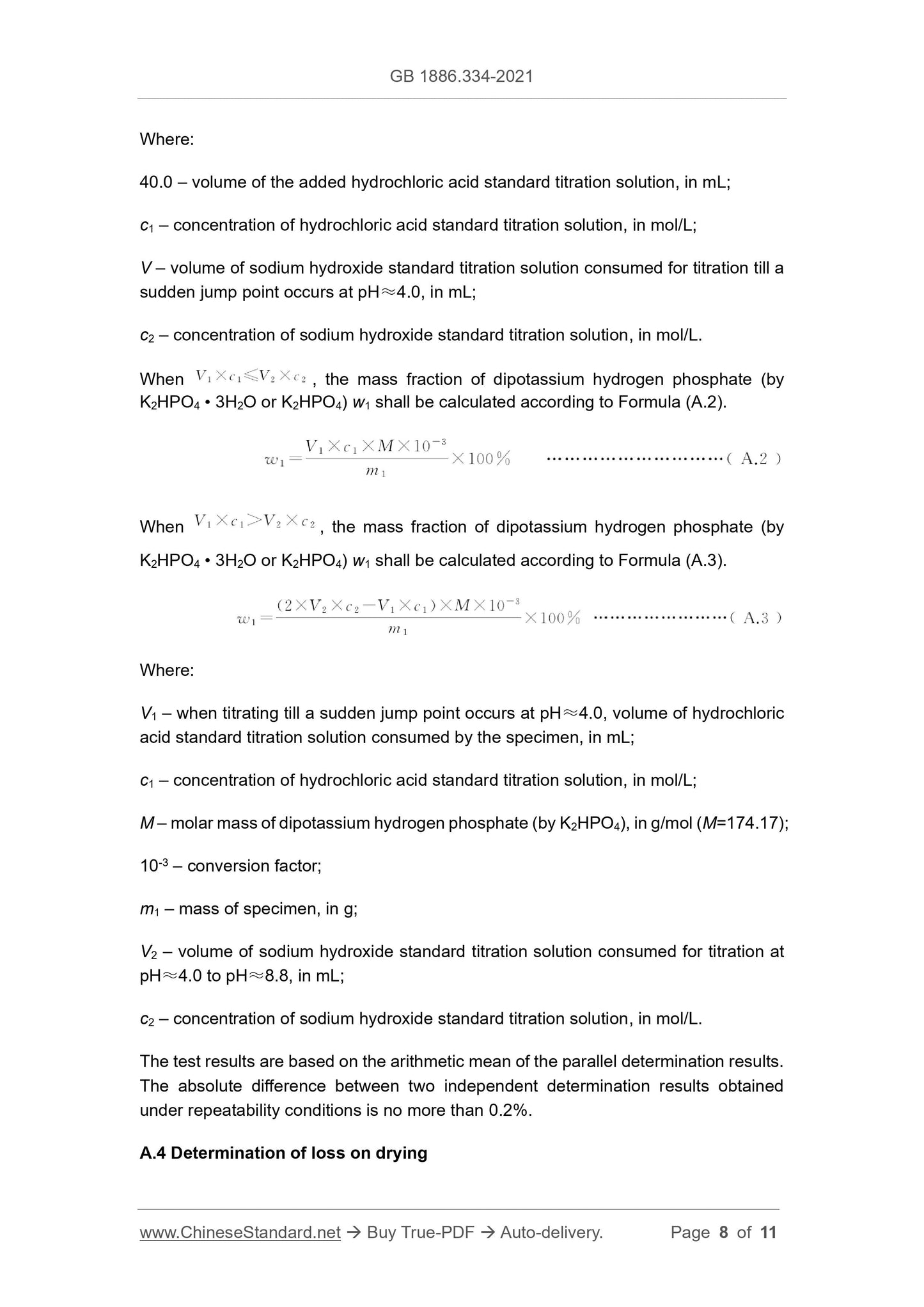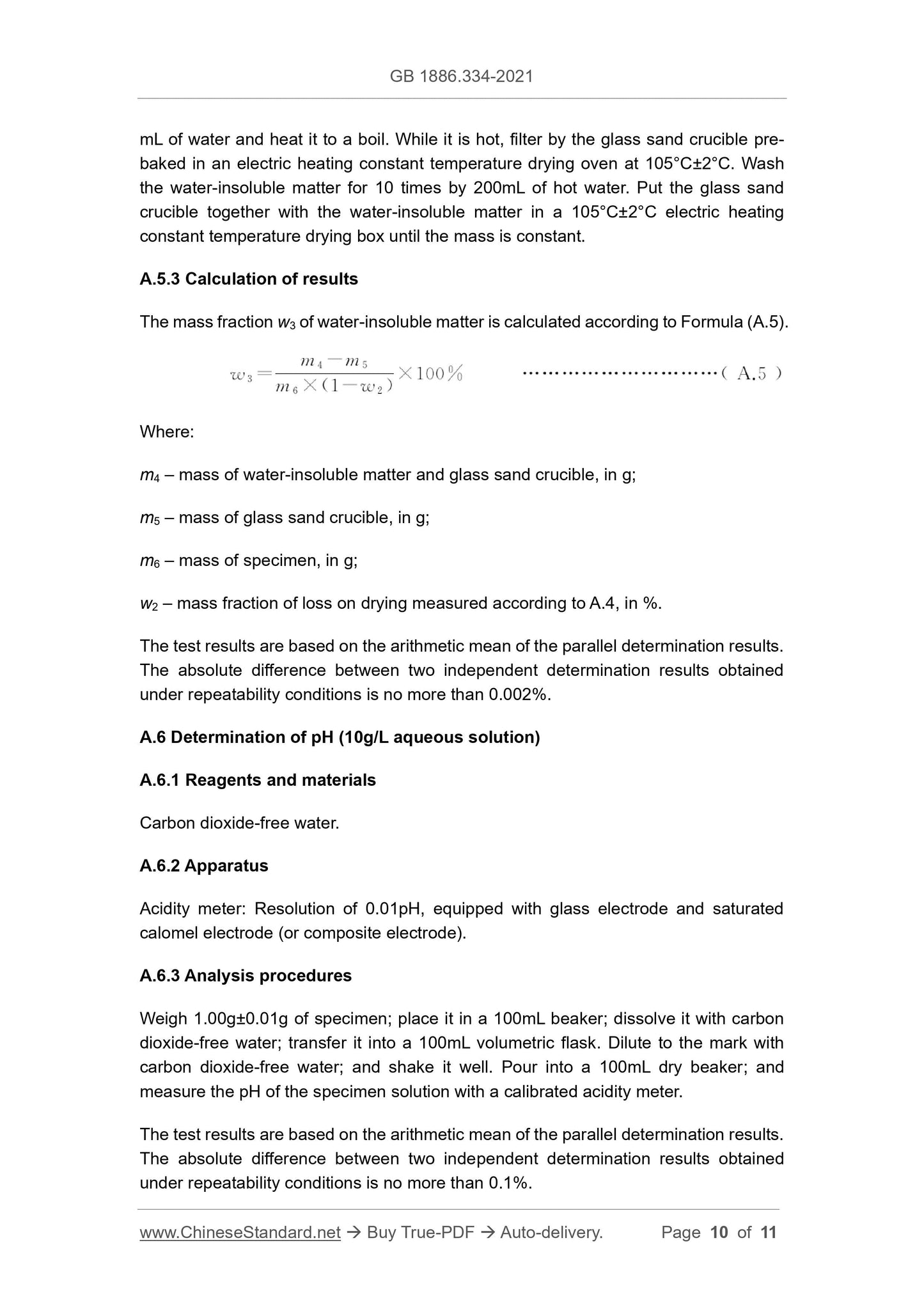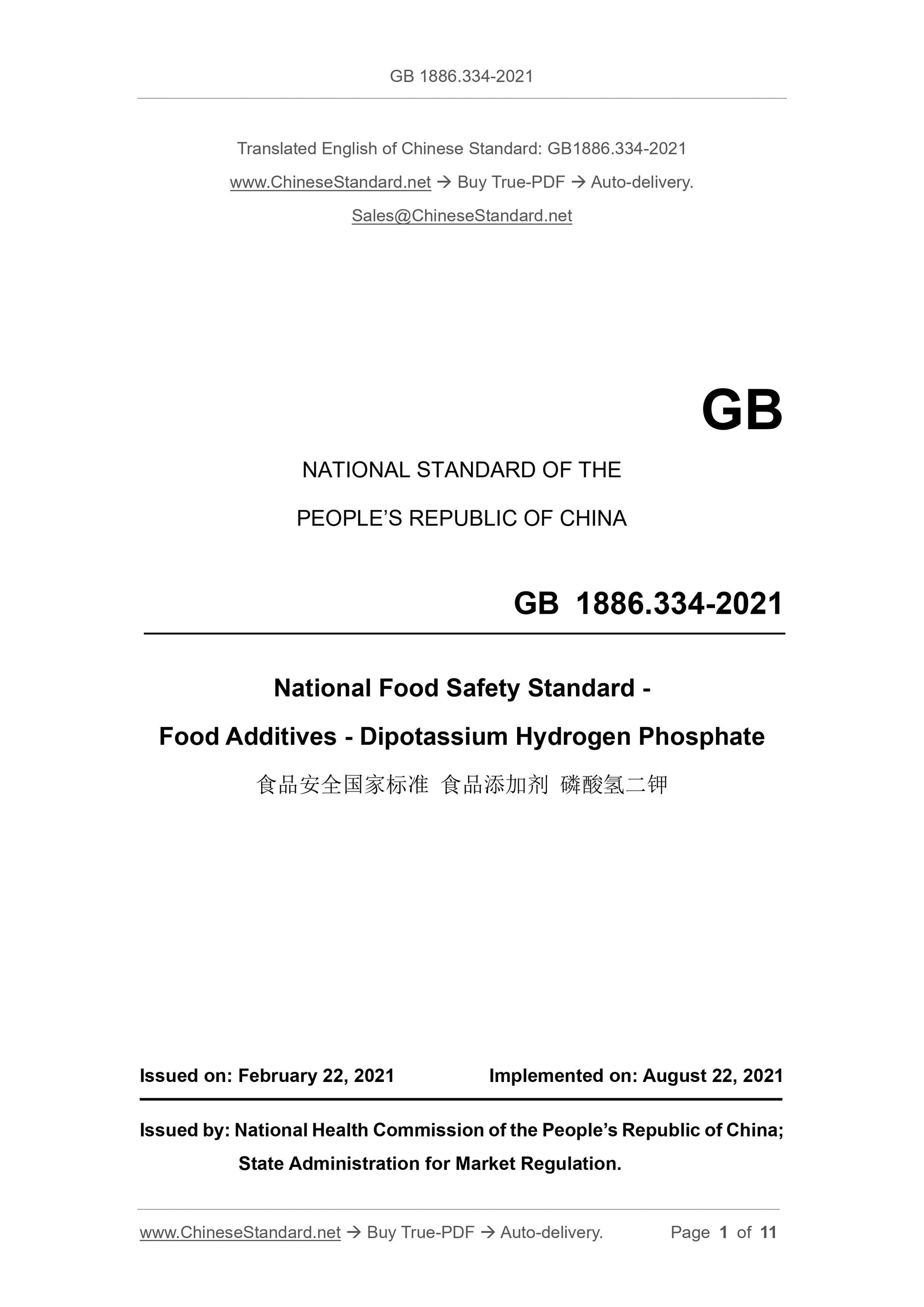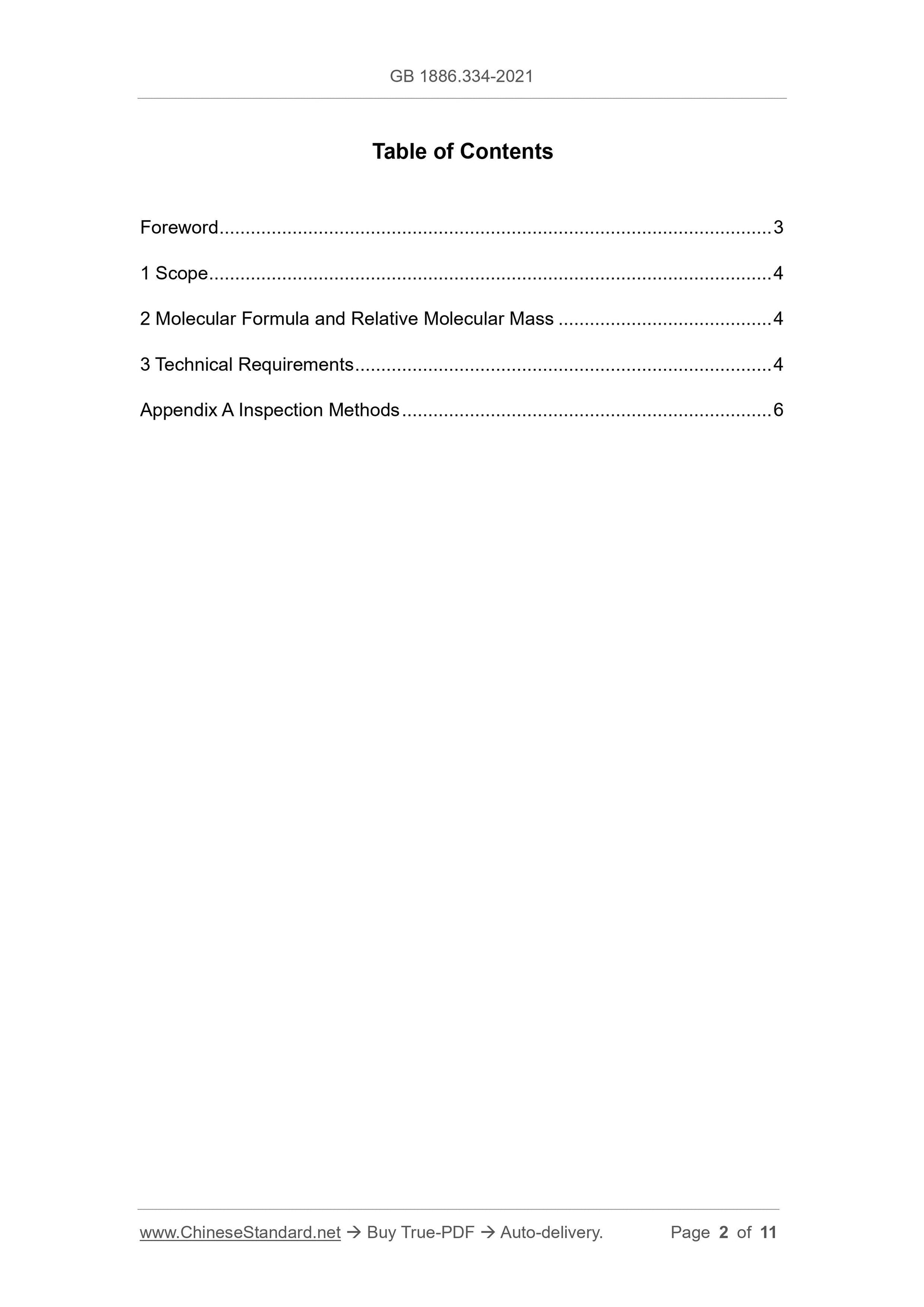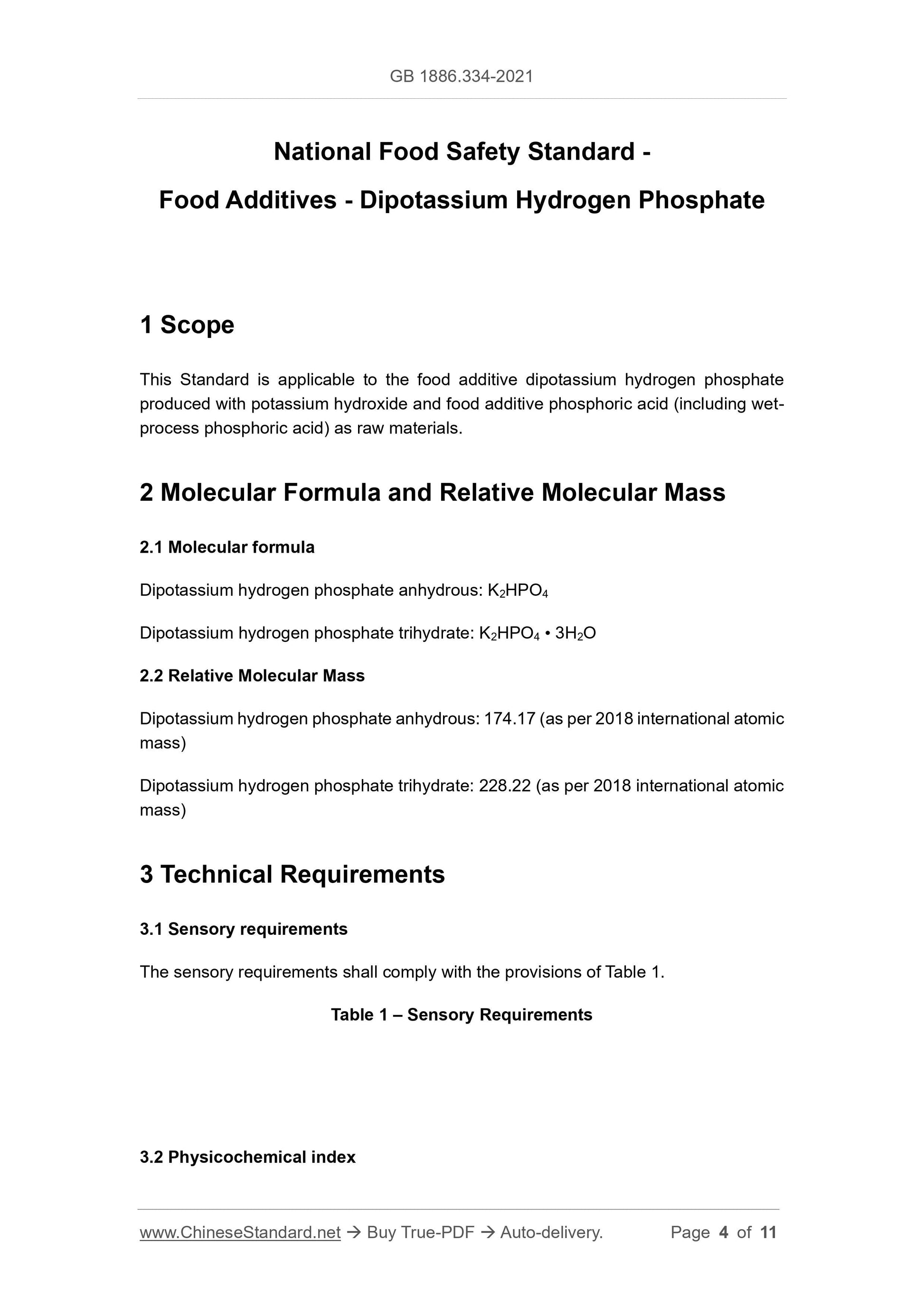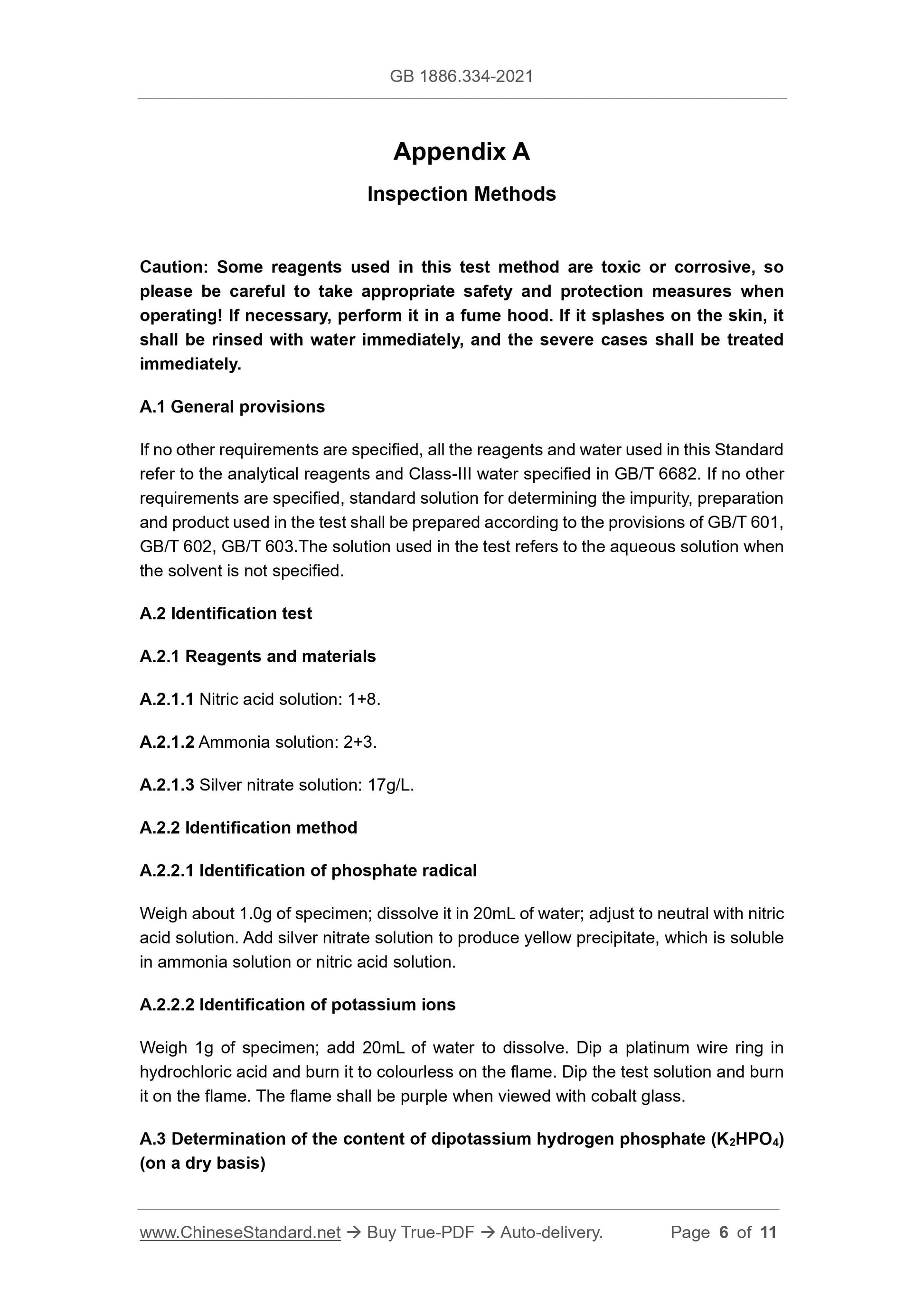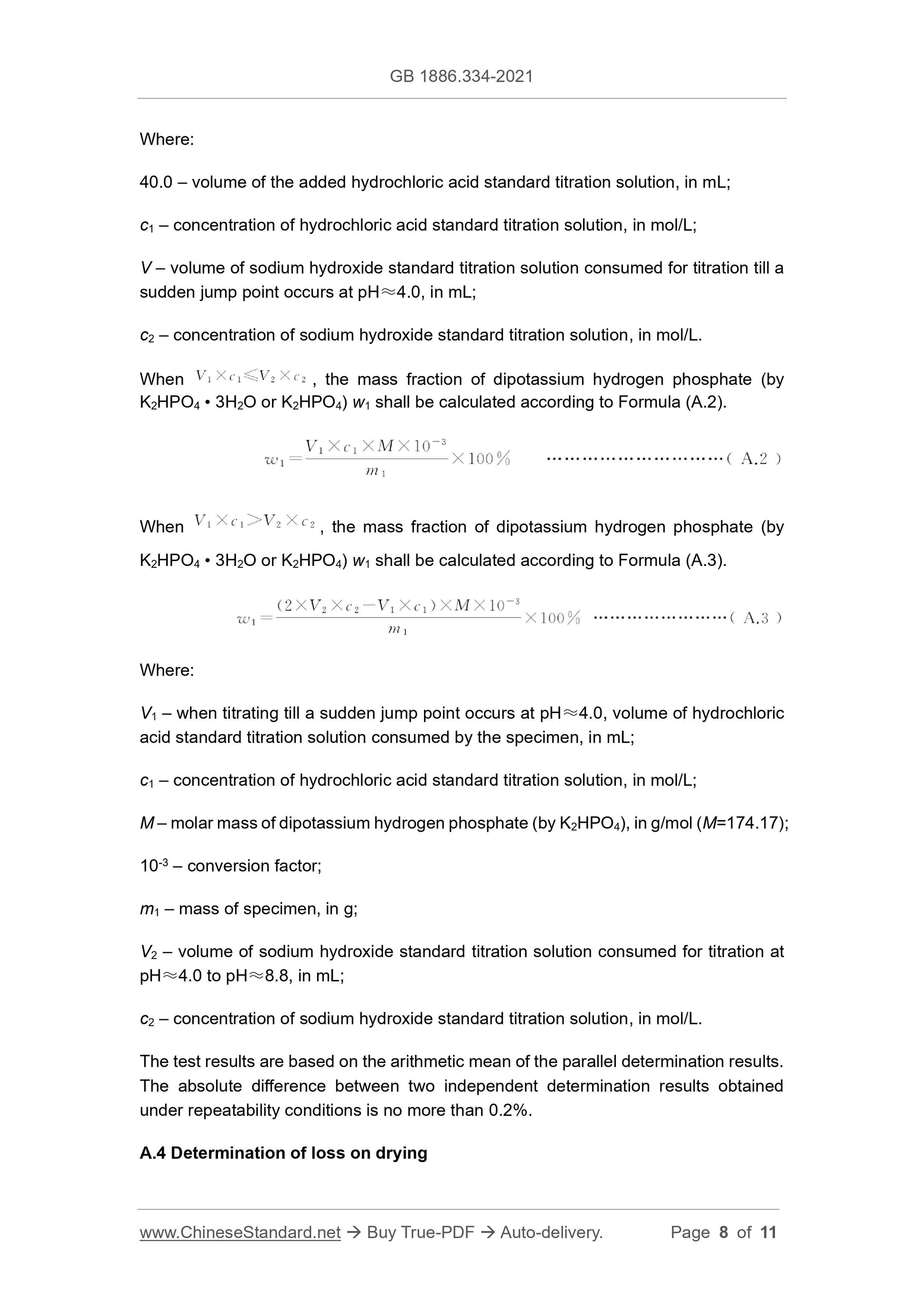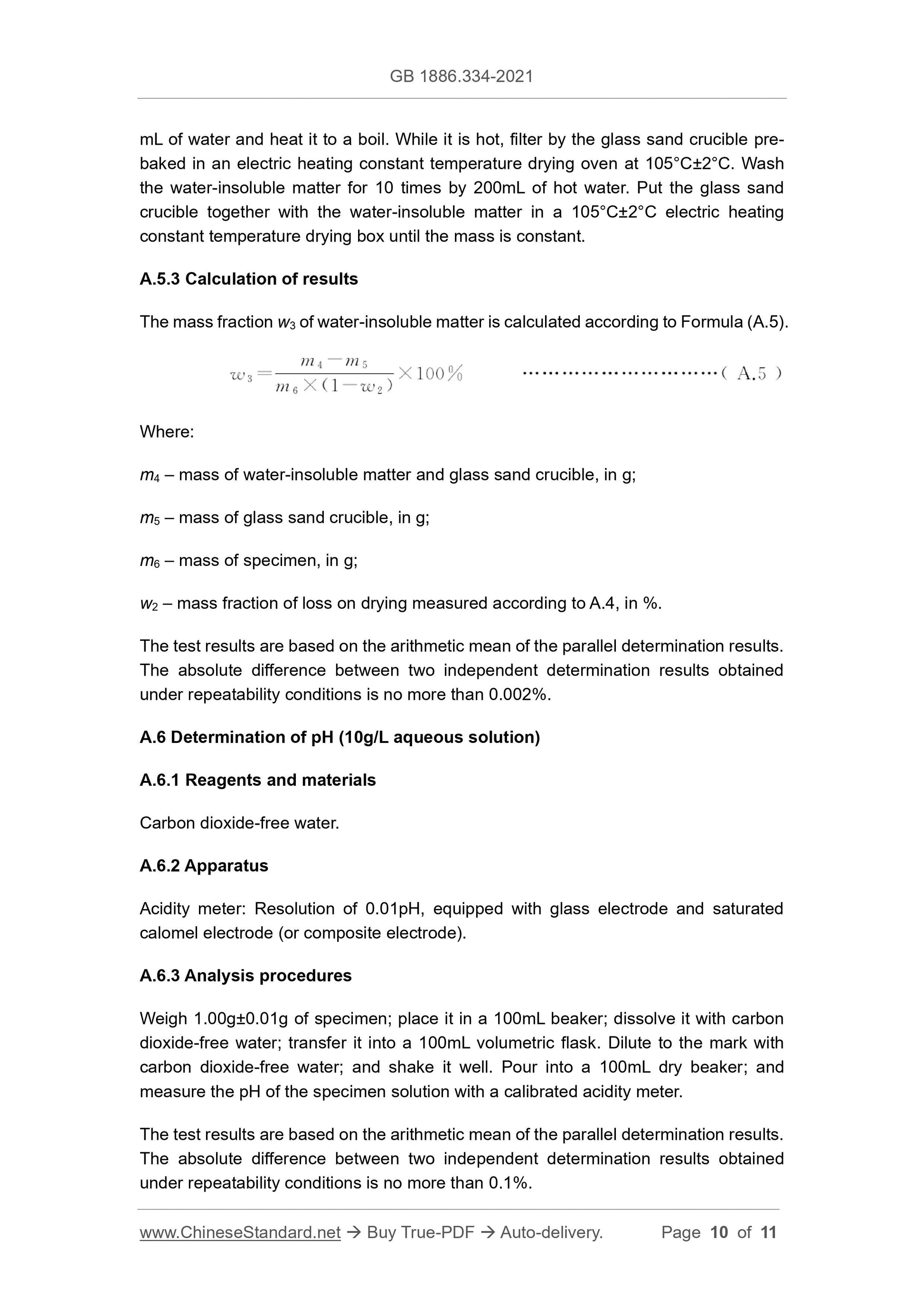1
/
of
6
PayPal, credit cards. Download editable-PDF & invoice in 1 second!
GB 1886.334-2021 English PDF (GB1886.334-2021)
GB 1886.334-2021 English PDF (GB1886.334-2021)
Regular price
$125.00 USD
Regular price
Sale price
$125.00 USD
Unit price
/
per
Shipping calculated at checkout.
Couldn't load pickup availability
Delivery: 3 seconds. Download true-PDF + Invoice.
Get QUOTATION in 1-minute: Click GB 1886.334-2021
Historical versions: GB 1886.334-2021
Preview True-PDF (Reload/Scroll if blank)
GB 1886.334-2021: National food safety standard - Food additives - Dipotassium hydrogenphosphate
GB 1886.334-2021
GB
NATIONAL STANDARD OF THE
PEOPLE’S REPUBLIC OF CHINA
National Food Safety Standard -
Food Additives - Dipotassium Hydrogen Phosphate
ISSUED ON: FEBRUARY 22, 2021
IMPLEMENTED ON: AUGUST 22, 2021
Issued by: National Health Commission of the People’s Republic of China;
State Administration for Market Regulation.
Table of Contents
Foreword ... 3
1 Scope ... 4
2 Molecular Formula and Relative Molecular Mass ... 4
3 Technical Requirements ... 4
Appendix A Inspection Methods ... 6
National Food Safety Standard -
Food Additives - Dipotassium Hydrogen Phosphate
1 Scope
This Standard is applicable to the food additive dipotassium hydrogen phosphate
produced with potassium hydroxide and food additive phosphoric acid (including wet-
process phosphoric acid) as raw materials.
2 Molecular Formula and Relative Molecular Mass
2.1 Molecular formula
Dipotassium hydrogen phosphate anhydrous: K2HPO4
Dipotassium hydrogen phosphate trihydrate: K2HPO4 • 3H2O
2.2 Relative Molecular Mass
Dipotassium hydrogen phosphate anhydrous: 174.17 (as per 2018 international atomic
mass)
Dipotassium hydrogen phosphate trihydrate: 228.22 (as per 2018 international atomic
mass)
3 Technical Requirements
3.1 Sensory requirements
The sensory requirements shall comply with the provisions of Table 1.
Table 1 – Sensory Requirements
3.2 Physicochemical index
Appendix A
Inspection Methods
Caution: Some reagents used in this test method are toxic or corrosive, so
please be careful to take appropriate safety and protection measures when
operating! If necessary, perform it in a fume hood. If it splashes on the skin, it
shall be rinsed with water immediately, and the severe cases shall be treated
immediately.
A.1 General provisions
If no other requirements are specified, all the reagents and water used in this Standard
refer to the analytical reagents and Class-III water specified in GB/T 6682. If no other
requirements are specified, standard solution for determining the impurity, preparation
and product used in the test shall be prepared according to the provisions of GB/T 601,
GB/T 602, GB/T 603.The solution used in the test refers to the aqueous solution when
the solvent is not specified.
A.2 Identification test
A.2.1 Reagents and materials
A.2.1.1 Nitric acid solution: 1+8.
A.2.1.2 Ammonia solution: 2+3.
A.2.1.3 Silver nitrate solution: 17g/L.
A.2.2 Identification method
A.2.2.1 Identification of phosphate radical
Weigh about 1.0g of specimen; dissolve it in 20mL of water; adjust to neutral with nitric
acid solution. Add silver nitrate solution to produce yellow precipitate, which is soluble
in ammonia solution or nitric acid solution.
A.2.2.2 Identification of potassium ions
Weigh 1g of specimen; add 20mL of water to dissolve. Dip a platinum wire ring in
hydrochloric acid and burn it to colourless on the flame. Dip the test solution and burn
it on the flame. The flame shall be purple when viewed with cobalt glass.
A.3 Determination of the content of dipotassium hydrogen phosphate (K2HPO4)
(on a dry basis)
Where:
40.0 – volume of the added hydrochloric acid standard titration solution, in mL;
c1 – concentration of hydrochloric acid standard titration solution, in mol/L;
V – volume of sodium hydroxide standard titration solution consumed for titration till a
sudden jump point occurs at pH≈4.0, in mL;
c2 – concentration of sodium hydroxide standard titration solution, in mol/L.
When , the mass fraction of dipotassium hydrogen phosphate (by
K2HPO4 • 3H2O or K2HPO4) w1 shall be calculated according to Formula (A.2).
When , the mass fraction of dipotassium hydrogen phosphate (by
K2HPO4 • 3H2O or K2HPO4) w1 shall be calculated according to Formula (A.3).
Where:
V1 – when titrating till a sudden jump point occurs at pH≈4.0, volume of hydrochloric
acid standard titration solution consumed by the specimen, in mL;
c1 – concentration of hydrochloric acid standard titration solution, in mol/L;
M – molar mass of dipotassium hydrogen phosphate (by K2HPO4), in g/mol (M=174.17);
10-3 – conversion factor;
m1 – mass of specimen, in g;
V2 – volume of sodium hydroxide standard titration solution consumed for titration at
pH≈4.0 to pH≈8.8, in mL;
c2 – concentration of sodium hydroxide standard titration solution, in mol/L.
The test results are based on the arithmetic mean of the parallel determination results.
The absolute difference between two independent determination results obtained
under repeatability conditions is no more than 0.2%.
A.4 Determination of loss on drying
mL of water and heat it to a boil. While it is hot, filter by the glass sand crucible pre-
baked in an electric heating constant temperature drying oven at 105°C±2°C. Wash
the water-insoluble matter for 10 times by 200mL of hot water. Put the glass sand
crucible together with the water-insoluble matter in a 105°C±2°C electric heating
constant temperature drying box until the mass is constant.
A.5.3 Calculation of results
The mass fraction w3 of water-insoluble matter is calculated according to Formula (A.5).
Where:
m4 – mass of water-insoluble matter and glass sand crucible, in g;
m5 – mass of glass sand crucible, in g;
m6 – mass of specimen, in g;
w2 – mass fraction of loss on drying measured according to A.4, in %.
The test results are based on the arithmetic mean of the parallel determination results.
The absolute difference between two independent determination results obtained
under repeatability conditions is no more than 0.002%.
A.6 Determination of pH (10g/L aqueous solution)
A.6.1 Reagents and materials
Carbon dioxide-free water.
A.6.2 Apparatus
Acidity meter: Resolution of 0.01pH, equipped with glass electrode and saturated
calomel electrode (or composite electrode).
A.6.3 Analysis procedures
Weigh 1.00g±0.01g of specimen; place it in a 100mL beaker; dissolve it with carbon
dioxide-free water; transfer it into a 100mL volumetric flask. Dilute to the mark with
carbon dioxide-free water; and shake it well. Pour into a 100mL dry beaker; and
measure the pH of the specimen solution with a calibrated acidity meter.
The test results are based on the arithmetic mean of the parallel determination results.
The absolute difference between two independent determination results obtained
under repeatability conditions is no more than 0.1%.
Get QUOTATION in 1-minute: Click GB 1886.334-2021
Historical versions: GB 1886.334-2021
Preview True-PDF (Reload/Scroll if blank)
GB 1886.334-2021: National food safety standard - Food additives - Dipotassium hydrogenphosphate
GB 1886.334-2021
GB
NATIONAL STANDARD OF THE
PEOPLE’S REPUBLIC OF CHINA
National Food Safety Standard -
Food Additives - Dipotassium Hydrogen Phosphate
ISSUED ON: FEBRUARY 22, 2021
IMPLEMENTED ON: AUGUST 22, 2021
Issued by: National Health Commission of the People’s Republic of China;
State Administration for Market Regulation.
Table of Contents
Foreword ... 3
1 Scope ... 4
2 Molecular Formula and Relative Molecular Mass ... 4
3 Technical Requirements ... 4
Appendix A Inspection Methods ... 6
National Food Safety Standard -
Food Additives - Dipotassium Hydrogen Phosphate
1 Scope
This Standard is applicable to the food additive dipotassium hydrogen phosphate
produced with potassium hydroxide and food additive phosphoric acid (including wet-
process phosphoric acid) as raw materials.
2 Molecular Formula and Relative Molecular Mass
2.1 Molecular formula
Dipotassium hydrogen phosphate anhydrous: K2HPO4
Dipotassium hydrogen phosphate trihydrate: K2HPO4 • 3H2O
2.2 Relative Molecular Mass
Dipotassium hydrogen phosphate anhydrous: 174.17 (as per 2018 international atomic
mass)
Dipotassium hydrogen phosphate trihydrate: 228.22 (as per 2018 international atomic
mass)
3 Technical Requirements
3.1 Sensory requirements
The sensory requirements shall comply with the provisions of Table 1.
Table 1 – Sensory Requirements
3.2 Physicochemical index
Appendix A
Inspection Methods
Caution: Some reagents used in this test method are toxic or corrosive, so
please be careful to take appropriate safety and protection measures when
operating! If necessary, perform it in a fume hood. If it splashes on the skin, it
shall be rinsed with water immediately, and the severe cases shall be treated
immediately.
A.1 General provisions
If no other requirements are specified, all the reagents and water used in this Standard
refer to the analytical reagents and Class-III water specified in GB/T 6682. If no other
requirements are specified, standard solution for determining the impurity, preparation
and product used in the test shall be prepared according to the provisions of GB/T 601,
GB/T 602, GB/T 603.The solution used in the test refers to the aqueous solution when
the solvent is not specified.
A.2 Identification test
A.2.1 Reagents and materials
A.2.1.1 Nitric acid solution: 1+8.
A.2.1.2 Ammonia solution: 2+3.
A.2.1.3 Silver nitrate solution: 17g/L.
A.2.2 Identification method
A.2.2.1 Identification of phosphate radical
Weigh about 1.0g of specimen; dissolve it in 20mL of water; adjust to neutral with nitric
acid solution. Add silver nitrate solution to produce yellow precipitate, which is soluble
in ammonia solution or nitric acid solution.
A.2.2.2 Identification of potassium ions
Weigh 1g of specimen; add 20mL of water to dissolve. Dip a platinum wire ring in
hydrochloric acid and burn it to colourless on the flame. Dip the test solution and burn
it on the flame. The flame shall be purple when viewed with cobalt glass.
A.3 Determination of the content of dipotassium hydrogen phosphate (K2HPO4)
(on a dry basis)
Where:
40.0 – volume of the added hydrochloric acid standard titration solution, in mL;
c1 – concentration of hydrochloric acid standard titration solution, in mol/L;
V – volume of sodium hydroxide standard titration solution consumed for titration till a
sudden jump point occurs at pH≈4.0, in mL;
c2 – concentration of sodium hydroxide standard titration solution, in mol/L.
When , the mass fraction of dipotassium hydrogen phosphate (by
K2HPO4 • 3H2O or K2HPO4) w1 shall be calculated according to Formula (A.2).
When , the mass fraction of dipotassium hydrogen phosphate (by
K2HPO4 • 3H2O or K2HPO4) w1 shall be calculated according to Formula (A.3).
Where:
V1 – when titrating till a sudden jump point occurs at pH≈4.0, volume of hydrochloric
acid standard titration solution consumed by the specimen, in mL;
c1 – concentration of hydrochloric acid standard titration solution, in mol/L;
M – molar mass of dipotassium hydrogen phosphate (by K2HPO4), in g/mol (M=174.17);
10-3 – conversion factor;
m1 – mass of specimen, in g;
V2 – volume of sodium hydroxide standard titration solution consumed for titration at
pH≈4.0 to pH≈8.8, in mL;
c2 – concentration of sodium hydroxide standard titration solution, in mol/L.
The test results are based on the arithmetic mean of the parallel determination results.
The absolute difference between two independent determination results obtained
under repeatability conditions is no more than 0.2%.
A.4 Determination of loss on drying
mL of water and heat it to a boil. While it is hot, filter by the glass sand crucible pre-
baked in an electric heating constant temperature drying oven at 105°C±2°C. Wash
the water-insoluble matter for 10 times by 200mL of hot water. Put the glass sand
crucible together with the water-insoluble matter in a 105°C±2°C electric heating
constant temperature drying box until the mass is constant.
A.5.3 Calculation of results
The mass fraction w3 of water-insoluble matter is calculated according to Formula (A.5).
Where:
m4 – mass of water-insoluble matter and glass sand crucible, in g;
m5 – mass of glass sand crucible, in g;
m6 – mass of specimen, in g;
w2 – mass fraction of loss on drying measured according to A.4, in %.
The test results are based on the arithmetic mean of the parallel determination results.
The absolute difference between two independent determination results obtained
under repeatability conditions is no more than 0.002%.
A.6 Determination of pH (10g/L aqueous solution)
A.6.1 Reagents and materials
Carbon dioxide-free water.
A.6.2 Apparatus
Acidity meter: Resolution of 0.01pH, equipped with glass electrode and saturated
calomel electrode (or composite electrode).
A.6.3 Analysis procedures
Weigh 1.00g±0.01g of specimen; place it in a 100mL beaker; dissolve it with carbon
dioxide-free water; transfer it into a 100mL volumetric flask. Dilute to the mark with
carbon dioxide-free water; and shake it well. Pour into a 100mL dry beaker; and
measure the pH of the specimen solution with a calibrated acidity meter.
The test results are based on the arithmetic mean of the parallel determination results.
The absolute difference between two independent determination results obtained
under repeatability conditions is no more than 0.1%.
Share
